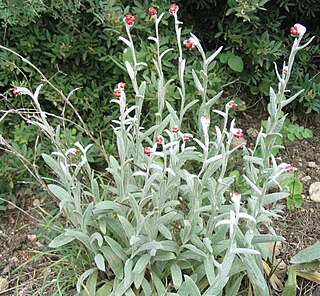
The genus Helichrysum consists of an estimated 600 species of flowering plants in the sunflower family (Asteraceae). The type species is Helichrysum orientale. They often go by the names everlasting, immortelle, and strawflower. The name is derived from the Ancient Greek words ἥλιος and χρῡσός.

Echinacea angustifolia, the narrow-leaved purple coneflower or blacksamson echinacea, is a species of flowering plant in the family Asteraceae. It is native to North America, where it is widespread across much of the Great Plains of central Canada and the central United States, with additional populations in surrounding regions.

Typha latifolia is a perennial herbaceous wetland plant in the genus Typha. It is known in English as bulrush, and in American as broadleaf cattail. It is found as a native plant species throughout most of Eurasia and North America, and more locally in Africa and South America. The genome of T. latifolia was published in 2022.
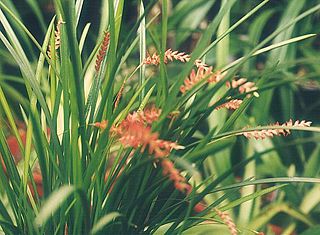
Dendrochilum was a genus of epiphytic, lithophytic and a few terrestrial flowering plants in the orchid family (Orchidaceae). It is now considered to be a synonym of Coelogyne Lindl. The name of this genus was derived from Ancient Greek words dendron ("tree"), and either cheilos ("lip") or chilos, alluding to either the flowers' large lip or to their epiphytic growth. These orchids are popular among orchid collectors.

Stephanotis is a genus of flowering plants first described in 1806. The name derives from the Greek στεφανωτής (stephanōtís) meaning, by sense, “fit for a crown”—from στέφανος (stéphanos), “crown”. It contains evergreen, woody-stemmed lianas with a scattered distribution in several tropical and subtropical regions.

Fraxinus angustifolia, the narrow-leaved ash, is a species of Fraxinus native to Central Europe and Southern Europe, Northwest Africa, and Southwest Asia.

Kalmia angustifolia is a flowering shrub in the family Ericaceae, commonly known as sheep laurel. It is distributed in eastern North America from Ontario and Quebec south to Virginia. It grows commonly in dry habitats in the boreal forest, and may become dominant over large areas after fire or logging. Like many plant species of infertile habitats it has evergreen leaves and mycorrhizal associations with fungi. It is also found in drier areas of peat bogs.
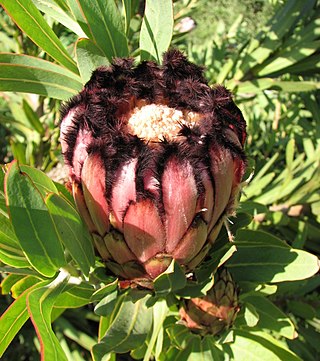
Protea neriifolia, also known as the narrow-leaf sugarbush, oleander-leaved sugarbush, blue sugarbush, or the oleanderleaf protea, is a flowering plant in the genus Protea, which is endemic to South Africa.

Typha angustifolia is a perennial herbaceous plant in the genus Typha, native throughout most of Eurasia and locally in northwest Africa; it also occurs widely in North America, where its native status is disputed. It is an "obligate wetland" species that is found in fresh water or brackish locations. It is known in English as lesser bulrush, and in American as narrowleaf cattail.

Rothmannia is a genus of flowering plants in the family Rubiaceae. It was described in 1776 and is named for Göran Rothman (1739–1778) by Thunberg – both were pupils of Linnaeus.

Malus angustifolia, or southern crabapple, is a species of crabapple native to the eastern and south-central United States.

Pentas lanceolata, commonly known as Egyptian starcluster, is a species of flowering plant in the madder family, Rubiaceae that is native to tropical Africa from Sudan to Democratic Republic of the Congo and Mozambique, as well as Saudi Arabia and Yemen on the Arabian Peninsula. It is known for its wide use as a garden plant where it often accompanies butterfly gardens.

Atractocarpus chartaceus, commonly known as the narrow-leaved gardenia, is a species of evergreen flowering plant in the coffee family Rubiaceae. It is found in subtropical rainforest of eastern Queensland, Australia, and it is cultivated for its fragrant flowers and colourful fruit.

Persoonia linearis, commonly known as the narrow-leaved geebung, is a shrub native to New South Wales and Victoria in eastern Australia. It reaches 3 m (9.8 ft), or occasionally 5 m (16 ft), in height and has thick, dark grey papery bark. The leaves are, as the species name suggests, more or less linear in shape, and are up to 9 cm (3.5 in) long, and 0.1 to 0.7 cm wide. The small yellow flowers appear in summer, autumn and early winter, followed by small green fleshy fruit known as drupes. Within the genus Persoonia, it is a member of the Lanceolata group of 58 closely related species. P. linearis interbreeds with several other species where they grow together.

Agathisanthemum is a genus of flowering plants in the family Rubiaceae. It was described by Johann Friedrich Klotzsch in 1861. It is found in tropical and southern Africa, on the Comoros and in Madagascar.

Curcuma angustifolia is one of over 80 species belonging to the genus Curcuma, in the family Zingiberaceae. This species is native to the Indian subcontinent and is more commonly known as East Indian arrowroot or narrow-leaved turmeric in English, and is called "yaipan" in Manipuri, "Aipah" in Thadou-Kuki, "tikhur" in Hindi, and "Koova" കൂവ in Malayalam/Tamil, and is called "Kutupah" in Poula. In the Eastern hemisphere, the plant plays an integral role in many cultures.

Pentanisia is a genus of flowering plants in the family Rubiaceae.
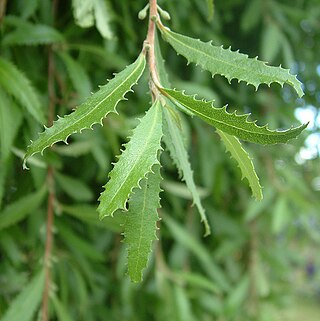
Hoheria angustifolia, the narrow-leaved lacebark or narrow-leaved houhere, is a species of flowering plant in the family Malvaceae, endemic to New Zealand. It is an evergreen tree or shrub with a weeping habit and grows to 10 m (33 ft) tall. Known as Houhere or Houhi in Māori, the bark of the tree was occasionally used for traditional textiles, similar to the traditional use of Hoheria populnea.
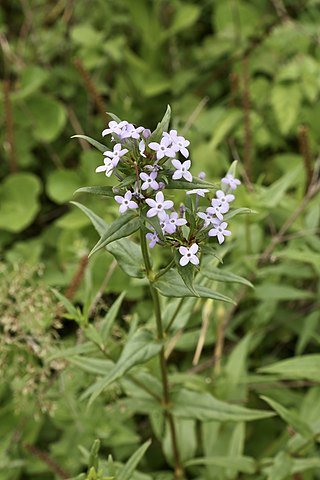
Conostomium is a genus of flowering plants in the family Rubiaceae. The genus is found from Ethiopia to South Africa.

Phillyrea angustifolia, the narrow-leaved mock privet, is a species of flowering plant in the olive family Oleaceae, native to the western and central Mediterranean.




















